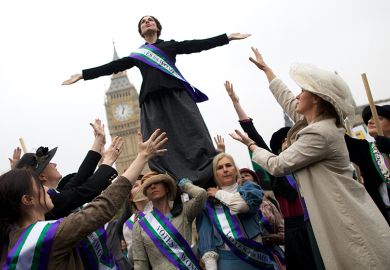For many centuries, the art world in the West was predominantly a male preserve where the female body was painted by men through a male gaze. Although some exceptionally talented and determined women did manage to break through the bastions of male power and win recognition, their contribution to art has largely been hidden in the accounts written by historians. This highly readable book, lavishly illustrated with high-quality reproductions of relevant visual material, explores an aspect of this neglected theme, female self-portraits.
In a useful introduction, Frances Borzello, a specialist in the social history of art, places her discussion within the wider context of the social position of women within European society. She points out that since women were traditionally defined as self-sacrificing wives and mothers who put the interests of their husbands and families first, they were not encouraged to compete or excel nor considered able enough to be trained as artists.
Indeed, it was not until the second half of the 19th century that art schools began accepting women students, although there were some previous occasions when women were allowed to train. Pursuing an artistic career, even after training, was not an easy path since the "obstacle race", as Germaine Greer termed it, continued.
As a minority member of the artistic profession, the female artist was constrained by conventions that made it exceptionally difficult for her to set up in business - those who succeeded in doing so being regarded as not only deviant artists but also as deviant women. Women artists, therefore, had to think carefully about the visual representation of the self, only too aware that such images would be scrutinised in a way that male self-portraits would not be.
In particular, until the 20th century, the conventions of womanliness in regard to dress and behaviour had to be taken into consideration. Thus, rather than present themselves in characteristically "unfeminine" poses, such as sitting with crossed legs, gesticulating or showing their teeth, women artists tended to stress their "comeliness" in their self-portraits. Borzello takes a chronological approach as she provides a skilful overview of continuities and changes in such self-representations from the 16th to the 20th century.
It is in the convents of medieval Europe that we can find some of the earliest self-portraits by women, together with limited biographical information. Claricia, for example, painted her self-portrait in a typically modest way, within the large capital letters on illustrated manuscripts.
Although such pioneering women were among the first to work out how they should represent themselves, it was not until the 17th century that a new self-confidence became evident, as in the self-portraits by the English artist, Mary Beale. After the collapse of her husband's post in the Patents Office in London, the family moved to Hampshire where Mary became the family breadwinner, a situation that she seemed to relish with pride in paintings of herself with her family.
Single women, however, could experience greater difficulty in acquiring a respectable professional status since their association with the opposite sex could result in innuendo and even scandal, as in the case of the 18th-century artist, Angelica Kauffman. Her first marriage, to a bigamist, only added to her notoriety, especially when, in 1775, the Irish artist Nathaniel Hone attacked her pictorially. It was not until her second marriage that she seems to have gained respectability, a factor that she chose to emphasise in her refined self-images.
The opening from 1850 of art schools to women seemed to encourage an output of female self-portraits that displayed a sense of the artist wrestling with her art rather than the 18th-century necessity for "ingratiating femininity". The Polish artist Anna Bilinska, for example, painted herself in 1887 taking a break from her work, the apron and untidy hair being signs that the hard work of creation had no longer to be disguised. Such new self-images paved the way for the breaking of taboos in the 20th century when women no longer felt shackled by traditional notions of feminine behaviour.
Although common themes throughout women's self-portraits, such as musical talent, motherhood and good looks, reappear in the 20th century, they are now treated with a new outspokenness alongside new topics, such as sexuality, pain, race, gender and disease.
The 1923 self-portrait by the American Romaine Brooks presents her in a stylish masculine image, an indication of the new wave of thinking where women artists could speak freely about their sexuality. This process of self-scrutiny, where photographers and artists fed off each other, is dramatically evident too in the series of self-portraits by the Mexican artist Frida Kahlo who, when 18 years old, broke her spine in a bus accident. Responsible for bringing pain into female self-portraiture, she presents herself in one painting with a steel corset rammed through her body, tears in her eyes, nails in her flesh.
The advent of Second Wave feminism, from the late 1960s, heralded another wave of women artists whose influence is still felt today. "The personal is political", a slogan of those times, was frequently evident in female self-portraits as in the American Judy Chicago's photolithograph of herself from the waist down, withdrawing a tampon, or in the British artist Jo Spence's studies of herself fighting breast cancer. A key concern now was to reclaim the female body from its "imprisonment in art as a beautiful, voiceless object to be judged by male spectators".
In the past, women artists rarely knew what other women had painted so that each new generation had to think anew how to represent themselves. In contrast, contemporary women artists are now aware of two decades of feminist art-historical research, which has examined some of the more traditional images of the past as well as the more exploratory of the present. In particular, the advent of more abstract representations of the self now complicates the idea of how to define self-portraiture. Although Borzello touches on this theme, she does not explore the thorny issues which it raises, especially when she has argued so persuasively for treating female self-portraiture as a genre in its own right.
This splendid book is a tour de force on self-portraiture in the western world that will be of interest to staff and students in higher education, as well as the general reader. Its lucid prose, evocative illustrations and handsome production make it a joy to read and savour.
June Purvis is professor of women's and gender history, University of Portsmouth.
Seeing Ourselves: Women's Self-Portraits
Author - Frances Borzello
ISBN - 0 500 01836 7
Publisher - Thames and Hudson
Price - £28.00
Pages - 224
Register to continue
Why register?
- Registration is free and only takes a moment
- Once registered, you can read 3 articles a month
- Sign up for our newsletter
Subscribe
Or subscribe for unlimited access to:
- Unlimited access to news, views, insights & reviews
- Digital editions
- Digital access to THE’s university and college rankings analysis
Already registered or a current subscriber?



